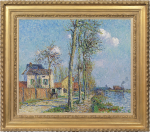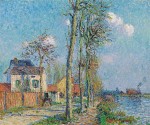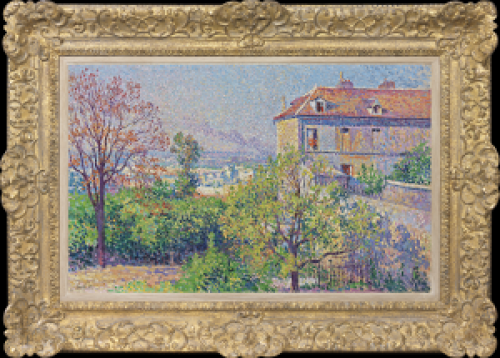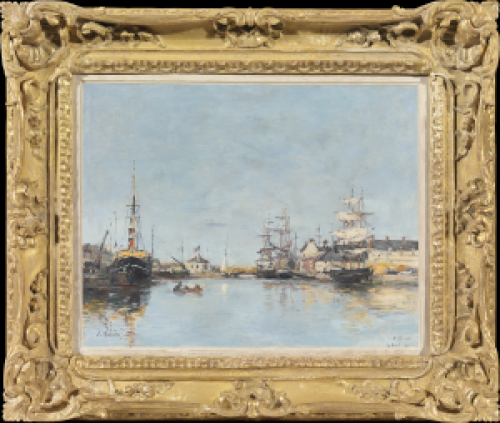GUSTAVE LOISEAU
1865 - Paris - 1935
Ref: CB 146
Le quai du Pothuis à Pontoise
Signed and dated lower right: G. Loiseau 1906
Oil on canvas: 21 ¼ x 25 5/8 in / 54 x 65.1 cm
Frame size: 29 x 34 in / 73.7 x 86.4 cm
Provenance:
Galeries Durand-Ruel, Paris, inv. no.8121
Carl Alvin and Erla Mae Texel Collection, Des Moines, Iowa;
by descent in a private collection, California
To be included in the catalogue raisonné of the work of Gustave Loiseau being prepared by Monsieur Didier Imbert, inv. no.A 309
Like many French artists, Gustave Loiseau divided his life between a studio in Paris, necessary for meeting dealers and colleagues and attending exhibitions, touring in search of new motifs, and spending time in a part of the country with familial associations. For Loiseau, this was Pontoise, on the river Oise about twenty-two miles north-west of Paris. Loiseau’s father, a butcher, had moved to the Ile-Saint-Louis in the centre of the capital in 1870, when Gustave was five. His parents retired and moved back to Pontoise a decade later, allowing Loiseau to explore the gentle, fertile rural landscape around the town, which had provided such a rich fund of subjects for Camille Pissarro when he lived there in the 1870s and early 1880s.
Le Quai du Pothuis à Pontoise brings out the vivid colours of a bright winter’s day, with scudding clouds, whitewashed houses and the warm tones of sunlight on the quayside fence. Loiseau boldly divides the composition in two with the slender, leafless trees, whose bark is woven with richly impasted touches of burgundy, orange, cream, green and blue. Loiseau’s subtle response to the qualities of light proclaims his love of painting en plein air, seeking to evoke an atmosphere beyond the mere observation of a fleeting moment in nature.
Pontoise was a bustling river port and a centre for barge traffic which transported grain from the vast fields of the Vexin plain. It also had several flourishing markets which had provided themes for Pissarro’s works. Across the river in Le Quai du Pothuis à Pontoise, Loiseau depicts a smoking factory chimney, a reminder that the age-old barge transport and agricultural life now existed alongside industrial development.
Loiseau made a very similar version of this view, with variants in the buildings and with the trees in dense leaf, Le Quai du Pothuis à Pontoise, 1905 (with Richard Green in 1995).
GUSTAVE LOISEAU
1865 – Paris – 1937
Gustave Loiseau is one of the most poetic and sensitive of the Post-Impressionists. His work shows the influence of Impressionist masters such as Alfred Sisley and Camille Pissarro and he briefly took advice from Paul Gauguin, whilst being a great admirer of Corot. Loiseau experimented with Pointillism, but developed his own style. He is considered to be a pure landscape artist, painting from direct observation of nature in a manner which is reminiscent of Claude Monet.
Loiseau was born in Paris, the son of a butcher from Pontoise who had moved to the Ile-Saint-Louis. He was apprenticed in 1880 to a painter and decorator, a job which he despised, but which confirmed his interest in art. Loiseau discovered the countryside of Pontoise when his parents retired there in 1881; a small legacy from his grandmother in 1887 spurred him to devote his life to landscape painting.
Loiseau studied at the Ecole des Arts Décoratifs and in 1889 at the studio of the landscape painter Fernand Quignon. Loiseau rented a room in a workers’ tenement, La Maison du Trappeur in the Rue Ravignon, Montmartre, which was later to become famous as the Bateau-Lavoir. He became acquainted with Jean-Louis Forain and Adolphe Willette, but his shy, nature-loving personality had little in common with the raucous bohemians of the Parisian art scene. In 1890 he went to Pont-Aven, staying at the famous inn run by Marie-Jeanne Gloanec, where he was befriended by Henry Moret and Maxime Maufra. Although working in a personal style, Loiseau’s paintings from this period show the influence of the Pont-Aven School in their diagonal compositions, shortened perspectives and anti-panoramic fields of view. Returning to Paris in 1891, Loiseau exhibited for the first time at the Fifth Exhibition of Impressionist and Symbolist Painters. He showed paintings at the gallery of Le Barc de Boutteville in Rue Le Pelletier, where two works were bought by the celebrated Rouen collector and friend of Monet, François Depeaux.
For much of his life Loiseau was based in Paris but travelled extensively through France, making repeated trips to Pont-Aven, where he was encouraged by Gauguin in 1894, to Normandy and to Pontoise. Described as ‘the historiographer of the Seine’, he also captured the shifting moods of the Oise and the Eure rivers and the Channel ports. Loiseau joined the Société des Artistes Indépendants in 1893. In 1897 he signed an agreement to sell most of his output to Paul Durand-Ruel, giving him the financial independence to travel more extensively. Loiseau divided his last years between Pontoise (where he is buried) and Paris, where he died in 1935.
The work of Gustave Loiseau is represented in the Musée d’Orsay, Paris; the Musée des Beaux-Arts, Rouen; the Ashmolean Museum, Oxford; the Marubeni Collection, Japan; the Metropolitan Museum of Art, New York; the Museum of Fine Arts, Boston and the Nelson-Atkins Museum of Art, Kansas City.




























